Leadership, Conflict, and Team Dynamics: A Detailed Case Study
VerifiedAdded on 2023/06/10
|8
|1917
|228
Case Study
AI Summary
This case study examines conflict within a sales team, focusing on issues of leadership, trust, and competition among high-performing members. The primary problem identified is the lack of effective leadership in addressing conflicts between team members Sophia and Emma, stemming from perceived unfairness in sector allocation. The solution explores conflict management strategies, emphasizing open communication, active listening, and negotiation to foster a win-win outcome. Furthermore, the study introduces servant leadership as a potential framework for improving team dynamics, promoting employee engagement, and resolving conflicts proactively. The analysis concludes by highlighting the importance of trust, motivation, and collaborative problem-solving in achieving organizational goals and creating a positive work environment. Desklib provides resources for students to explore similar case studies and access solved assignments.

Student Name
Course Name
University Name
11th-July-2018
Course Name
University Name
11th-July-2018
Paraphrase This Document
Need a fresh take? Get an instant paraphrase of this document with our AI Paraphraser
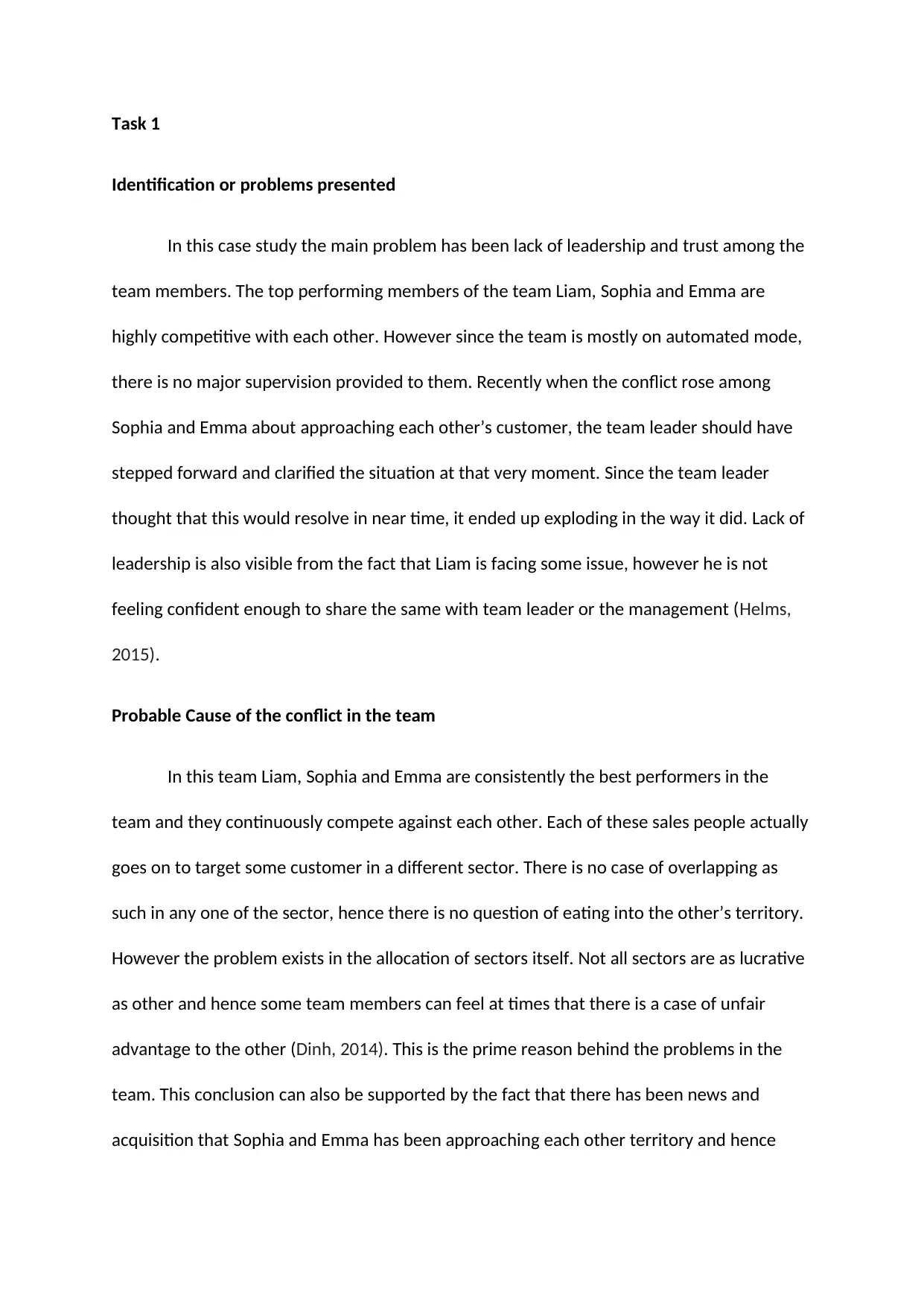
Task 1
Identification or problems presented
In this case study the main problem has been lack of leadership and trust among the
team members. The top performing members of the team Liam, Sophia and Emma are
highly competitive with each other. However since the team is mostly on automated mode,
there is no major supervision provided to them. Recently when the conflict rose among
Sophia and Emma about approaching each other’s customer, the team leader should have
stepped forward and clarified the situation at that very moment. Since the team leader
thought that this would resolve in near time, it ended up exploding in the way it did. Lack of
leadership is also visible from the fact that Liam is facing some issue, however he is not
feeling confident enough to share the same with team leader or the management (Helms,
2015).
Probable Cause of the conflict in the team
In this team Liam, Sophia and Emma are consistently the best performers in the
team and they continuously compete against each other. Each of these sales people actually
goes on to target some customer in a different sector. There is no case of overlapping as
such in any one of the sector, hence there is no question of eating into the other’s territory.
However the problem exists in the allocation of sectors itself. Not all sectors are as lucrative
as other and hence some team members can feel at times that there is a case of unfair
advantage to the other (Dinh, 2014). This is the prime reason behind the problems in the
team. This conclusion can also be supported by the fact that there has been news and
acquisition that Sophia and Emma has been approaching each other territory and hence
Identification or problems presented
In this case study the main problem has been lack of leadership and trust among the
team members. The top performing members of the team Liam, Sophia and Emma are
highly competitive with each other. However since the team is mostly on automated mode,
there is no major supervision provided to them. Recently when the conflict rose among
Sophia and Emma about approaching each other’s customer, the team leader should have
stepped forward and clarified the situation at that very moment. Since the team leader
thought that this would resolve in near time, it ended up exploding in the way it did. Lack of
leadership is also visible from the fact that Liam is facing some issue, however he is not
feeling confident enough to share the same with team leader or the management (Helms,
2015).
Probable Cause of the conflict in the team
In this team Liam, Sophia and Emma are consistently the best performers in the
team and they continuously compete against each other. Each of these sales people actually
goes on to target some customer in a different sector. There is no case of overlapping as
such in any one of the sector, hence there is no question of eating into the other’s territory.
However the problem exists in the allocation of sectors itself. Not all sectors are as lucrative
as other and hence some team members can feel at times that there is a case of unfair
advantage to the other (Dinh, 2014). This is the prime reason behind the problems in the
team. This conclusion can also be supported by the fact that there has been news and
acquisition that Sophia and Emma has been approaching each other territory and hence
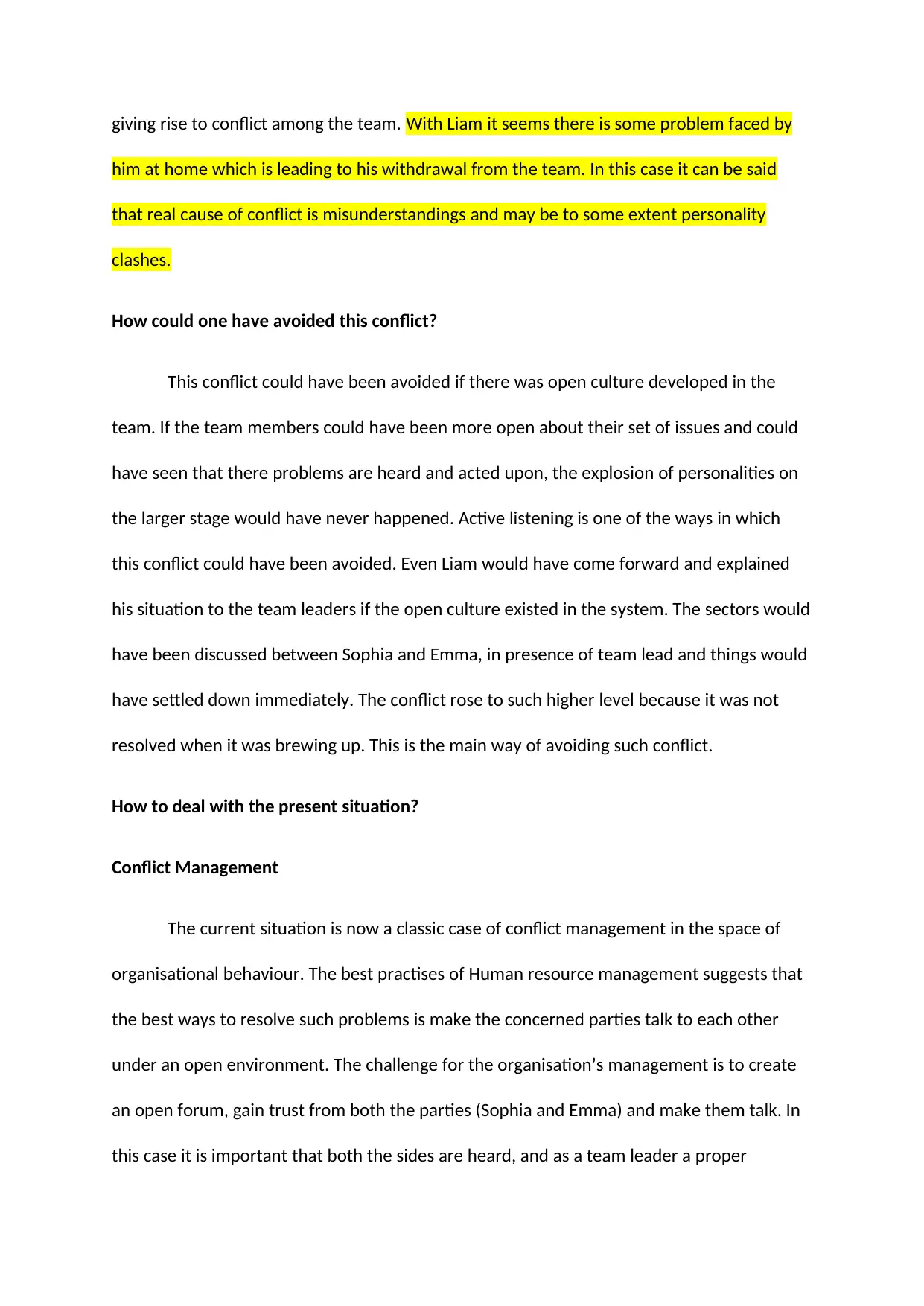
giving rise to conflict among the team. With Liam it seems there is some problem faced by
him at home which is leading to his withdrawal from the team. In this case it can be said
that real cause of conflict is misunderstandings and may be to some extent personality
clashes.
How could one have avoided this conflict?
This conflict could have been avoided if there was open culture developed in the
team. If the team members could have been more open about their set of issues and could
have seen that there problems are heard and acted upon, the explosion of personalities on
the larger stage would have never happened. Active listening is one of the ways in which
this conflict could have been avoided. Even Liam would have come forward and explained
his situation to the team leaders if the open culture existed in the system. The sectors would
have been discussed between Sophia and Emma, in presence of team lead and things would
have settled down immediately. The conflict rose to such higher level because it was not
resolved when it was brewing up. This is the main way of avoiding such conflict.
How to deal with the present situation?
Conflict Management
The current situation is now a classic case of conflict management in the space of
organisational behaviour. The best practises of Human resource management suggests that
the best ways to resolve such problems is make the concerned parties talk to each other
under an open environment. The challenge for the organisation’s management is to create
an open forum, gain trust from both the parties (Sophia and Emma) and make them talk. In
this case it is important that both the sides are heard, and as a team leader a proper
him at home which is leading to his withdrawal from the team. In this case it can be said
that real cause of conflict is misunderstandings and may be to some extent personality
clashes.
How could one have avoided this conflict?
This conflict could have been avoided if there was open culture developed in the
team. If the team members could have been more open about their set of issues and could
have seen that there problems are heard and acted upon, the explosion of personalities on
the larger stage would have never happened. Active listening is one of the ways in which
this conflict could have been avoided. Even Liam would have come forward and explained
his situation to the team leaders if the open culture existed in the system. The sectors would
have been discussed between Sophia and Emma, in presence of team lead and things would
have settled down immediately. The conflict rose to such higher level because it was not
resolved when it was brewing up. This is the main way of avoiding such conflict.
How to deal with the present situation?
Conflict Management
The current situation is now a classic case of conflict management in the space of
organisational behaviour. The best practises of Human resource management suggests that
the best ways to resolve such problems is make the concerned parties talk to each other
under an open environment. The challenge for the organisation’s management is to create
an open forum, gain trust from both the parties (Sophia and Emma) and make them talk. In
this case it is important that both the sides are heard, and as a team leader a proper
⊘ This is a preview!⊘
Do you want full access?
Subscribe today to unlock all pages.

Trusted by 1+ million students worldwide
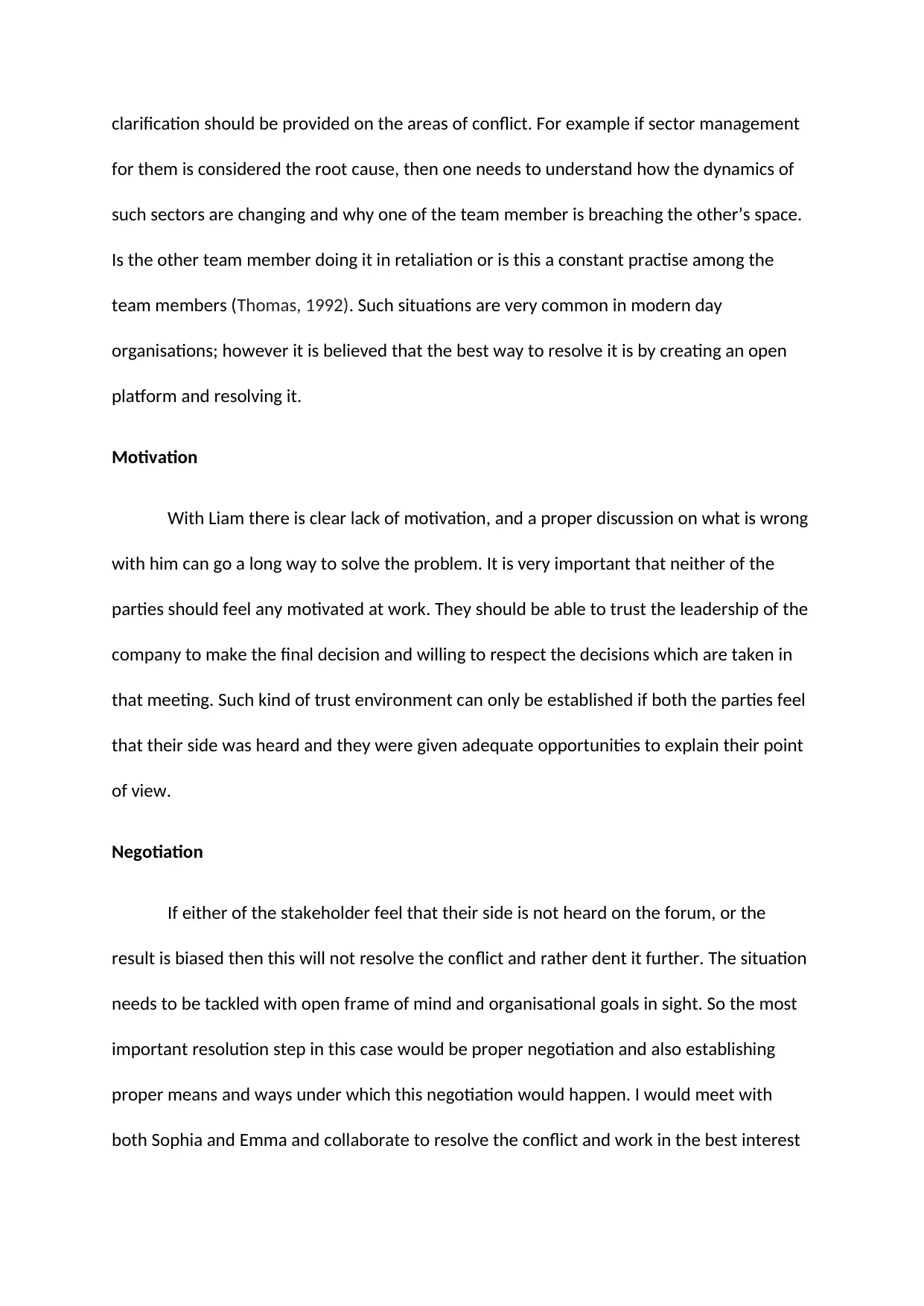
clarification should be provided on the areas of conflict. For example if sector management
for them is considered the root cause, then one needs to understand how the dynamics of
such sectors are changing and why one of the team member is breaching the other’s space.
Is the other team member doing it in retaliation or is this a constant practise among the
team members (Thomas, 1992). Such situations are very common in modern day
organisations; however it is believed that the best way to resolve it is by creating an open
platform and resolving it.
Motivation
With Liam there is clear lack of motivation, and a proper discussion on what is wrong
with him can go a long way to solve the problem. It is very important that neither of the
parties should feel any motivated at work. They should be able to trust the leadership of the
company to make the final decision and willing to respect the decisions which are taken in
that meeting. Such kind of trust environment can only be established if both the parties feel
that their side was heard and they were given adequate opportunities to explain their point
of view.
Negotiation
If either of the stakeholder feel that their side is not heard on the forum, or the
result is biased then this will not resolve the conflict and rather dent it further. The situation
needs to be tackled with open frame of mind and organisational goals in sight. So the most
important resolution step in this case would be proper negotiation and also establishing
proper means and ways under which this negotiation would happen. I would meet with
both Sophia and Emma and collaborate to resolve the conflict and work in the best interest
for them is considered the root cause, then one needs to understand how the dynamics of
such sectors are changing and why one of the team member is breaching the other’s space.
Is the other team member doing it in retaliation or is this a constant practise among the
team members (Thomas, 1992). Such situations are very common in modern day
organisations; however it is believed that the best way to resolve it is by creating an open
platform and resolving it.
Motivation
With Liam there is clear lack of motivation, and a proper discussion on what is wrong
with him can go a long way to solve the problem. It is very important that neither of the
parties should feel any motivated at work. They should be able to trust the leadership of the
company to make the final decision and willing to respect the decisions which are taken in
that meeting. Such kind of trust environment can only be established if both the parties feel
that their side was heard and they were given adequate opportunities to explain their point
of view.
Negotiation
If either of the stakeholder feel that their side is not heard on the forum, or the
result is biased then this will not resolve the conflict and rather dent it further. The situation
needs to be tackled with open frame of mind and organisational goals in sight. So the most
important resolution step in this case would be proper negotiation and also establishing
proper means and ways under which this negotiation would happen. I would meet with
both Sophia and Emma and collaborate to resolve the conflict and work in the best interest
Paraphrase This Document
Need a fresh take? Get an instant paraphrase of this document with our AI Paraphraser
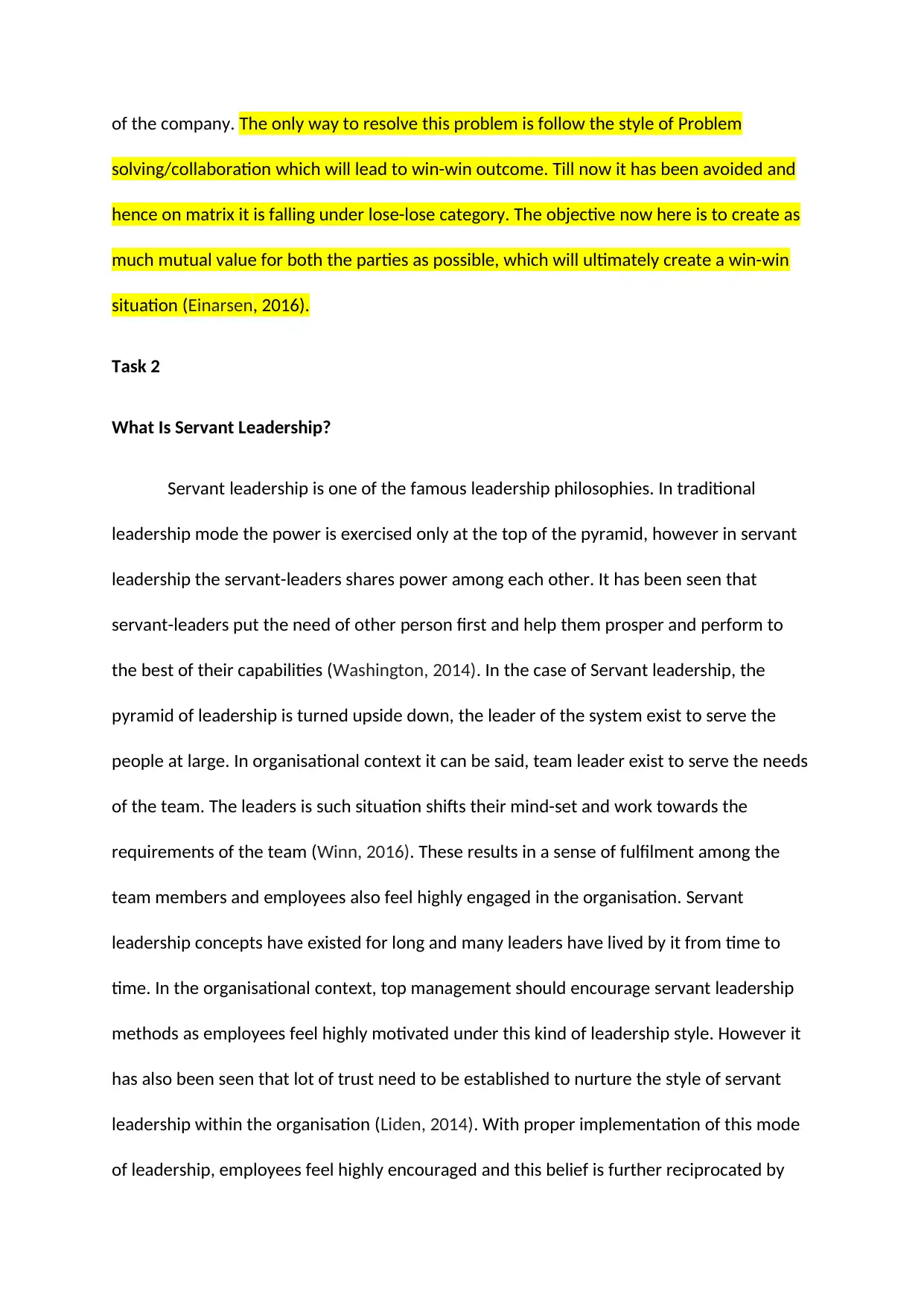
of the company. The only way to resolve this problem is follow the style of Problem
solving/collaboration which will lead to win-win outcome. Till now it has been avoided and
hence on matrix it is falling under lose-lose category. The objective now here is to create as
much mutual value for both the parties as possible, which will ultimately create a win-win
situation (Einarsen, 2016).
Task 2
What Is Servant Leadership?
Servant leadership is one of the famous leadership philosophies. In traditional
leadership mode the power is exercised only at the top of the pyramid, however in servant
leadership the servant-leaders shares power among each other. It has been seen that
servant-leaders put the need of other person first and help them prosper and perform to
the best of their capabilities (Washington, 2014). In the case of Servant leadership, the
pyramid of leadership is turned upside down, the leader of the system exist to serve the
people at large. In organisational context it can be said, team leader exist to serve the needs
of the team. The leaders is such situation shifts their mind-set and work towards the
requirements of the team (Winn, 2016). These results in a sense of fulfilment among the
team members and employees also feel highly engaged in the organisation. Servant
leadership concepts have existed for long and many leaders have lived by it from time to
time. In the organisational context, top management should encourage servant leadership
methods as employees feel highly motivated under this kind of leadership style. However it
has also been seen that lot of trust need to be established to nurture the style of servant
leadership within the organisation (Liden, 2014). With proper implementation of this mode
of leadership, employees feel highly encouraged and this belief is further reciprocated by
solving/collaboration which will lead to win-win outcome. Till now it has been avoided and
hence on matrix it is falling under lose-lose category. The objective now here is to create as
much mutual value for both the parties as possible, which will ultimately create a win-win
situation (Einarsen, 2016).
Task 2
What Is Servant Leadership?
Servant leadership is one of the famous leadership philosophies. In traditional
leadership mode the power is exercised only at the top of the pyramid, however in servant
leadership the servant-leaders shares power among each other. It has been seen that
servant-leaders put the need of other person first and help them prosper and perform to
the best of their capabilities (Washington, 2014). In the case of Servant leadership, the
pyramid of leadership is turned upside down, the leader of the system exist to serve the
people at large. In organisational context it can be said, team leader exist to serve the needs
of the team. The leaders is such situation shifts their mind-set and work towards the
requirements of the team (Winn, 2016). These results in a sense of fulfilment among the
team members and employees also feel highly engaged in the organisation. Servant
leadership concepts have existed for long and many leaders have lived by it from time to
time. In the organisational context, top management should encourage servant leadership
methods as employees feel highly motivated under this kind of leadership style. However it
has also been seen that lot of trust need to be established to nurture the style of servant
leadership within the organisation (Liden, 2014). With proper implementation of this mode
of leadership, employees feel highly encouraged and this belief is further reciprocated by
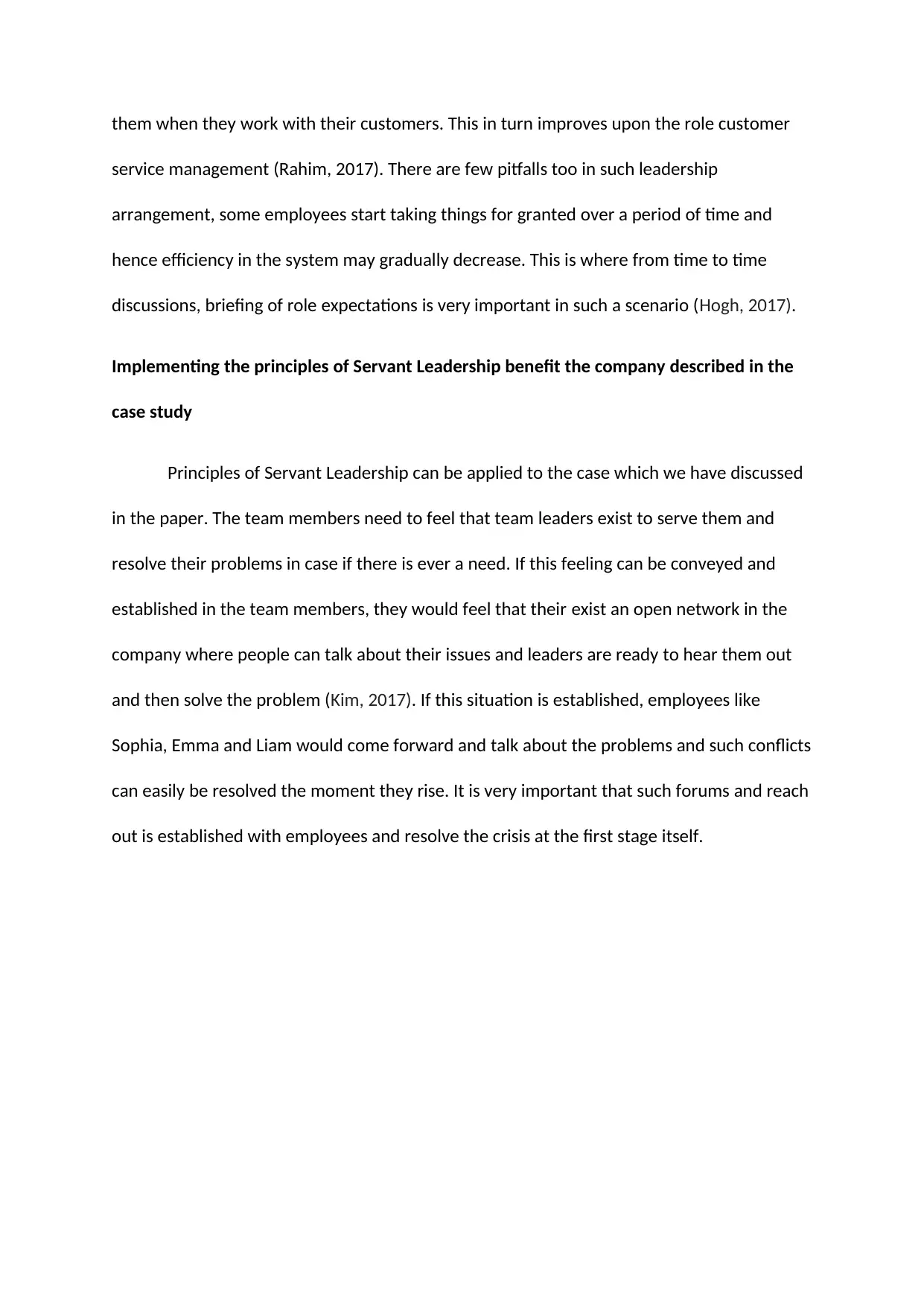
them when they work with their customers. This in turn improves upon the role customer
service management (Rahim, 2017). There are few pitfalls too in such leadership
arrangement, some employees start taking things for granted over a period of time and
hence efficiency in the system may gradually decrease. This is where from time to time
discussions, briefing of role expectations is very important in such a scenario (Hogh, 2017).
Implementing the principles of Servant Leadership benefit the company described in the
case study
Principles of Servant Leadership can be applied to the case which we have discussed
in the paper. The team members need to feel that team leaders exist to serve them and
resolve their problems in case if there is ever a need. If this feeling can be conveyed and
established in the team members, they would feel that their exist an open network in the
company where people can talk about their issues and leaders are ready to hear them out
and then solve the problem (Kim, 2017). If this situation is established, employees like
Sophia, Emma and Liam would come forward and talk about the problems and such conflicts
can easily be resolved the moment they rise. It is very important that such forums and reach
out is established with employees and resolve the crisis at the first stage itself.
service management (Rahim, 2017). There are few pitfalls too in such leadership
arrangement, some employees start taking things for granted over a period of time and
hence efficiency in the system may gradually decrease. This is where from time to time
discussions, briefing of role expectations is very important in such a scenario (Hogh, 2017).
Implementing the principles of Servant Leadership benefit the company described in the
case study
Principles of Servant Leadership can be applied to the case which we have discussed
in the paper. The team members need to feel that team leaders exist to serve them and
resolve their problems in case if there is ever a need. If this feeling can be conveyed and
established in the team members, they would feel that their exist an open network in the
company where people can talk about their issues and leaders are ready to hear them out
and then solve the problem (Kim, 2017). If this situation is established, employees like
Sophia, Emma and Liam would come forward and talk about the problems and such conflicts
can easily be resolved the moment they rise. It is very important that such forums and reach
out is established with employees and resolve the crisis at the first stage itself.
⊘ This is a preview!⊘
Do you want full access?
Subscribe today to unlock all pages.

Trusted by 1+ million students worldwide
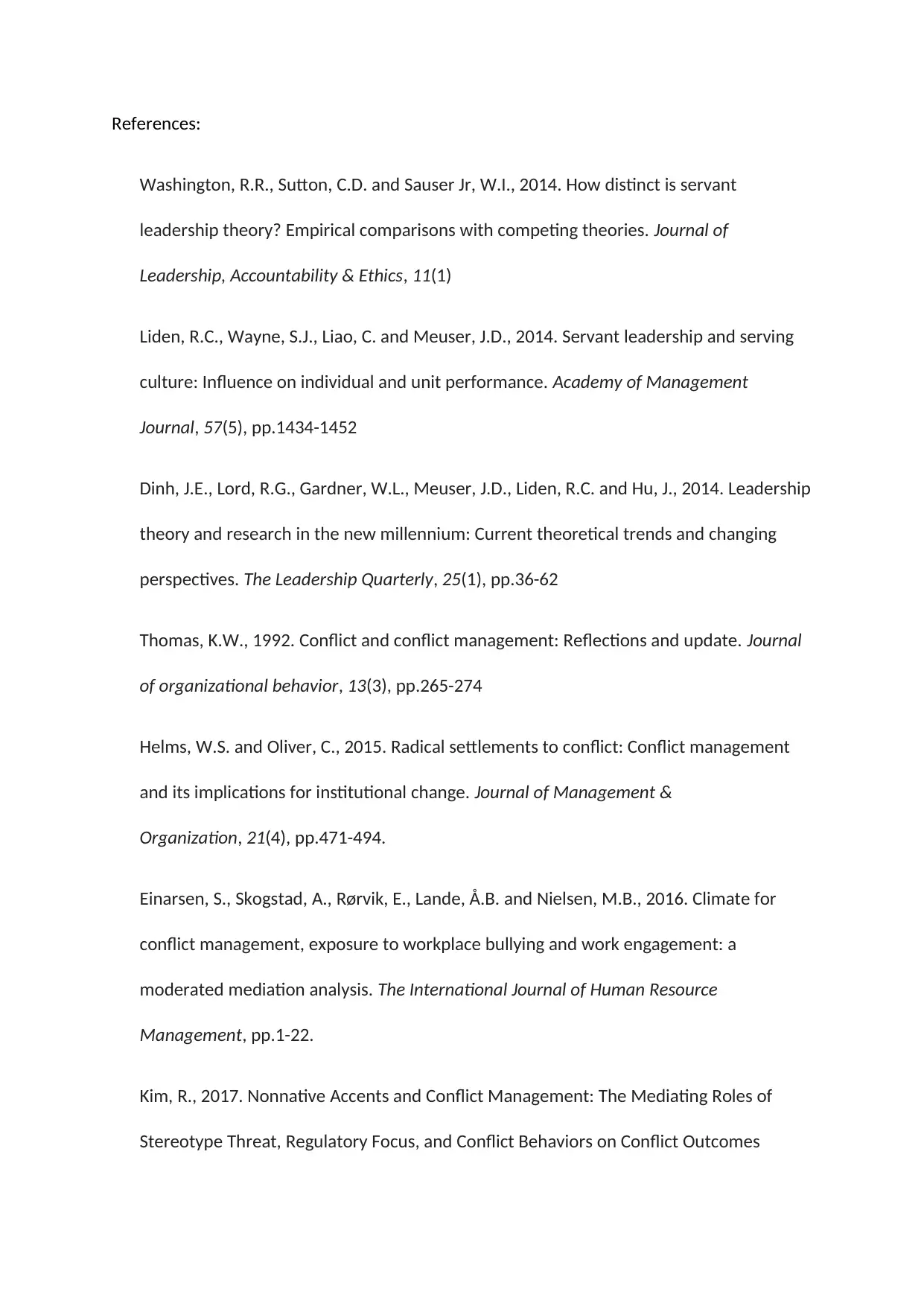
References:
Washington, R.R., Sutton, C.D. and Sauser Jr, W.I., 2014. How distinct is servant
leadership theory? Empirical comparisons with competing theories. Journal of
Leadership, Accountability & Ethics, 11(1)
Liden, R.C., Wayne, S.J., Liao, C. and Meuser, J.D., 2014. Servant leadership and serving
culture: Influence on individual and unit performance. Academy of Management
Journal, 57(5), pp.1434-1452
Dinh, J.E., Lord, R.G., Gardner, W.L., Meuser, J.D., Liden, R.C. and Hu, J., 2014. Leadership
theory and research in the new millennium: Current theoretical trends and changing
perspectives. The Leadership Quarterly, 25(1), pp.36-62
Thomas, K.W., 1992. Conflict and conflict management: Reflections and update. Journal
of organizational behavior, 13(3), pp.265-274
Helms, W.S. and Oliver, C., 2015. Radical settlements to conflict: Conflict management
and its implications for institutional change. Journal of Management &
Organization, 21(4), pp.471-494.
Einarsen, S., Skogstad, A., Rørvik, E., Lande, Å.B. and Nielsen, M.B., 2016. Climate for
conflict management, exposure to workplace bullying and work engagement: a
moderated mediation analysis. The International Journal of Human Resource
Management, pp.1-22.
Kim, R., 2017. Nonnative Accents and Conflict Management: The Mediating Roles of
Stereotype Threat, Regulatory Focus, and Conflict Behaviors on Conflict Outcomes
Washington, R.R., Sutton, C.D. and Sauser Jr, W.I., 2014. How distinct is servant
leadership theory? Empirical comparisons with competing theories. Journal of
Leadership, Accountability & Ethics, 11(1)
Liden, R.C., Wayne, S.J., Liao, C. and Meuser, J.D., 2014. Servant leadership and serving
culture: Influence on individual and unit performance. Academy of Management
Journal, 57(5), pp.1434-1452
Dinh, J.E., Lord, R.G., Gardner, W.L., Meuser, J.D., Liden, R.C. and Hu, J., 2014. Leadership
theory and research in the new millennium: Current theoretical trends and changing
perspectives. The Leadership Quarterly, 25(1), pp.36-62
Thomas, K.W., 1992. Conflict and conflict management: Reflections and update. Journal
of organizational behavior, 13(3), pp.265-274
Helms, W.S. and Oliver, C., 2015. Radical settlements to conflict: Conflict management
and its implications for institutional change. Journal of Management &
Organization, 21(4), pp.471-494.
Einarsen, S., Skogstad, A., Rørvik, E., Lande, Å.B. and Nielsen, M.B., 2016. Climate for
conflict management, exposure to workplace bullying and work engagement: a
moderated mediation analysis. The International Journal of Human Resource
Management, pp.1-22.
Kim, R., 2017. Nonnative Accents and Conflict Management: The Mediating Roles of
Stereotype Threat, Regulatory Focus, and Conflict Behaviors on Conflict Outcomes
Paraphrase This Document
Need a fresh take? Get an instant paraphrase of this document with our AI Paraphraser
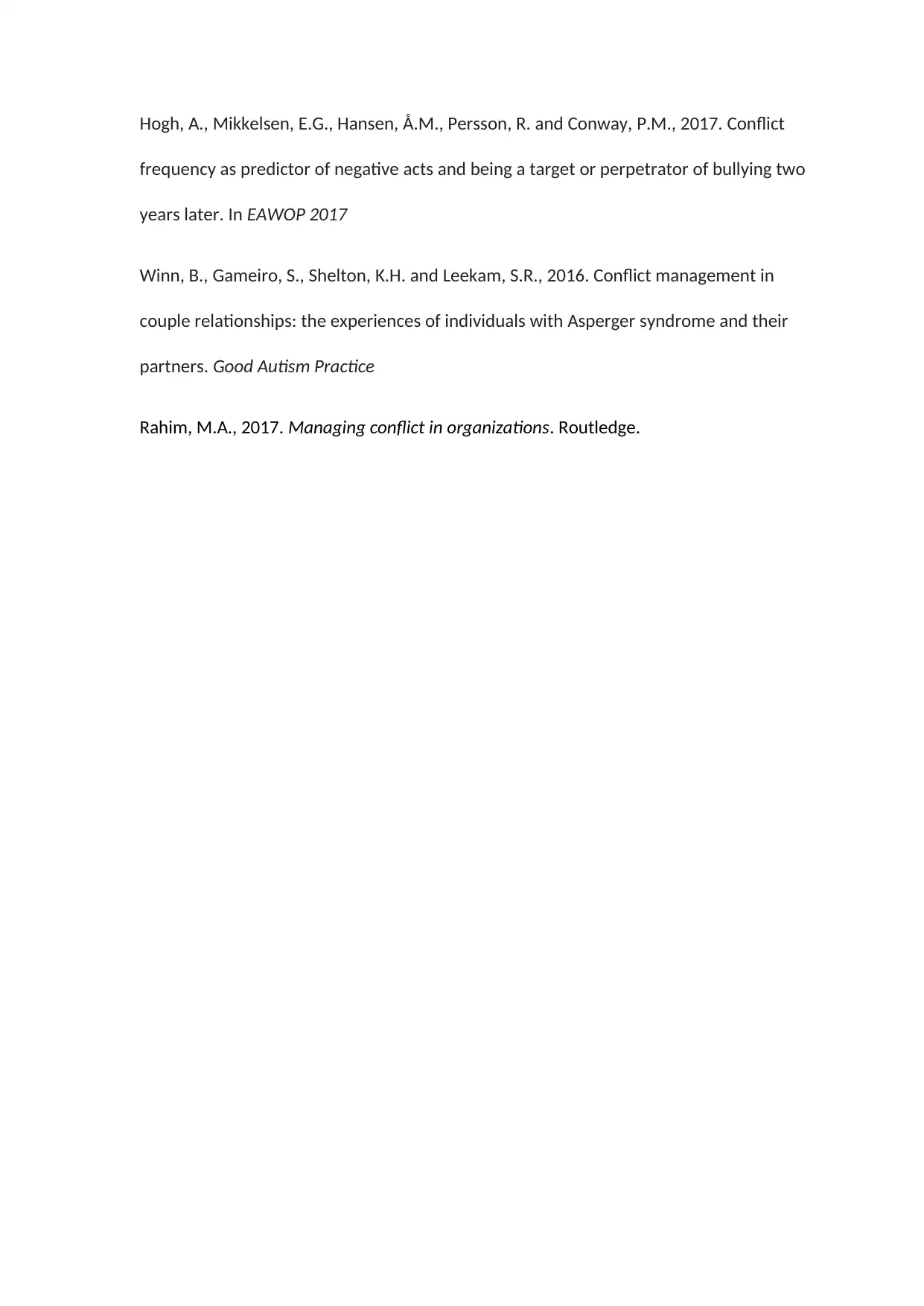
Hogh, A., Mikkelsen, E.G., Hansen, Å.M., Persson, R. and Conway, P.M., 2017. Conflict
frequency as predictor of negative acts and being a target or perpetrator of bullying two
years later. In EAWOP 2017
Winn, B., Gameiro, S., Shelton, K.H. and Leekam, S.R., 2016. Conflict management in
couple relationships: the experiences of individuals with Asperger syndrome and their
partners. Good Autism Practice
Rahim, M.A., 2017. Managing conflict in organizations. Routledge.
frequency as predictor of negative acts and being a target or perpetrator of bullying two
years later. In EAWOP 2017
Winn, B., Gameiro, S., Shelton, K.H. and Leekam, S.R., 2016. Conflict management in
couple relationships: the experiences of individuals with Asperger syndrome and their
partners. Good Autism Practice
Rahim, M.A., 2017. Managing conflict in organizations. Routledge.
1 out of 8
Related Documents
Your All-in-One AI-Powered Toolkit for Academic Success.
+13062052269
info@desklib.com
Available 24*7 on WhatsApp / Email
![[object Object]](/_next/static/media/star-bottom.7253800d.svg)
Unlock your academic potential
Copyright © 2020–2025 A2Z Services. All Rights Reserved. Developed and managed by ZUCOL.





